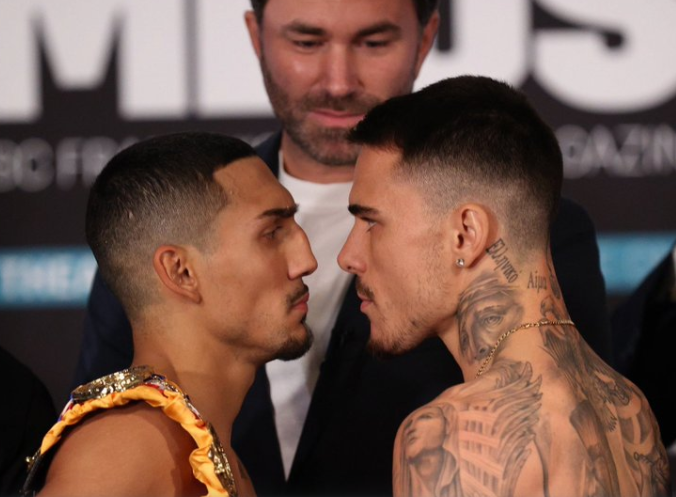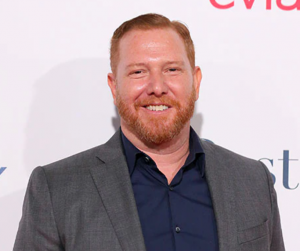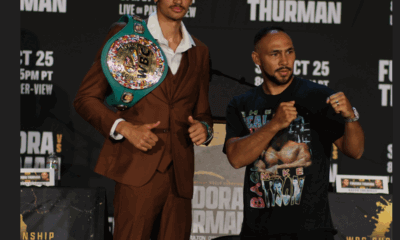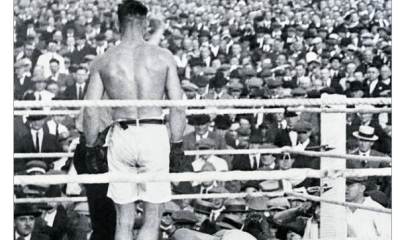Featured Articles
The Hauser Report: The Strange Odyssey of Lopez-Kambosos and Triller (Part One)

The Hauser Report: The Strange Odyssey of Lopez-Kambosos and Triller (Part One)
On Saturday night, November 27, Teofimo Lopez fought to defend his multiple 135-pound titles against George Kambosos at the Hulu Theater at Madison Square Garden. The primary storyline coming into the bout wasn’t the fight. Lopez was a 9-to-1 betting favorite, and very few people expected Lopez-Kambosos to be competitive. The fight generated publicity in the nine months that preceded it because of its business backstory. But Lopez-Kambosos evolved into a tense, hard-fought, bloody spectacle with Kambosos emerging victorious on a 115-111, 115-112, 113-114 split decision.
Lopez, now 24, turned pro after the 2016 Olympics. Top Rank (his promoter) put him on a fast track, and Teofimo delivered. He won the IBF lightweight title with an impressive second-round knockout of Richard Commey in 2019 and added the WBA and WBO belts to his inventory with a unanimous decision over Vasyl Lomachenko in October 2020. That brought his record to 16-0 with 12 knockouts.
Kambosos had pieced together a 19-0 (10 KOs) record against pedestrian opposition and became the IBF’s mandatory challenger by virtue of a split-decision victory over Lee Selby last year. In theory, boxing’s mandatory-challenger rule is designed to ensure that champions go in tough against the best available challenger at least once a year. But it has been subverted to the point where, too often, the mandatory challenger is an easy mark.
When boxing fans talked about dream fights to be made at 135 pounds, the names were Lopez, Vasyl Lomachenko, Devin Haney, Gervonta Davis, and Ryan Garcia. Kambosos wasn’t even in the conversation. But Lopez was obligated to fight him if he wanted to keep his IBF belt.
Top Rank, which had several years left on its promotional agreement with Lopez, offered Teofimo his contractual minimum of $1.25 million for the bout. David McWater (who manages Lopez) countered with a demand for $5.5 million. With a divide that wide, Kambosos’s demands were irrelevant. Under IBF rules, the matter went to a purse bid with the proceeds to be split 65-35% in favor of Team Lopez.
Enter Triller.
Triller’s origins were explored on this site in a two-part series entitled “Triller, Holyfield, and Trump: Did Evander Get Hustled?” The company is largely under the control of Ryan Kavanaugh, a 46-year-old businessman with a checkered past. Kavanaugh made headlines and a lot of money when he founded an entertainment company called Relativity Media that purported to use sophisticated algorithms to eliminate the risk from film financing. There were some big early successes. Then things fell apart and Relativity Media filed for bankruptcy. There have been numerous other legal proceedings involving Kavanaugh since then.

Ryan Kavanaugh
As with Relativity Media, Triller’s foray into boxing started with a commercial success – the November 28, 2020, exhibition between Mike Tyson and Roy Jones. Tyson-Jones was a way to drum up interest in, and exposure for, Triller. But the extraordinarily popular reception that it received encouraged Kavanaugh to delve further into the boxing business. Things have gone downhill from there.
Triller holds itself out as “a vehicle for fighters to grow their brand, connect with fans, and build their social media following as they progress in their careers.” Boxing on Triller is largely a social media event, which is not necessarily a bad thing for the sport. These days, presidential elections are won and lost on social media.
But we’re living in an age when some businesses are operated as financial instruments to be built up and sold for a profit rather than being run as self-sustaining businesses that are profitable in and of themselves. Triller might fit that mold.
The purse bid for Lopez-Kambosos was held on February 25, 2021. Considerable behind-the-scenes maneuvering preceded the opening of the envelopes.
On February 11, according to a report in The Athletic, Top Rank president Todd duBoef sent an email to Kevin A. Mayer (who was about to become the CEO of DAZN). That email read in part, “This is a follow-up to our conversation. Attached is an article which quotes Matchroom’s Eddie Hearn’s desire to make a bid on DAZN’s behalf for Teofimo Lopez v George Kambosos. Top Rank signed Lopez out of the Olympics and is in the middle of a long term Promotional Agreement. Lopez has been a mainstay and anchor on ESPN and ESPN+. If the article is true, I was shocked to see this brazen act by DAZN, particularly after I cleared ESPN programming off of May 8 for DAZN’s Canelo v Saunders big event, moving our scheduled event (Ramirez v Taylor) to later in the month. I appreciate your attention to this and look forward to starting our conversations in the coming weeks.”
Mayer, according to The Athletic, responded, “Thanks for sending this, Todd.” He then forwarded his response to DAZN Group COO Ed McCarthy with the notation, “Ed, let’s discuss, but I think Todd is making a fair point. He’s doing us a big favor on the Canelo fight. Let’s think hard about this please?”
“After the email exchange,”The Athletic reported, “McCarthy and duBoef spoke by telephone. Following that call, duBoef believed that Hearn wouldn’t bid on Lopez-Kambosos and that Top Rank could enter a bid that would win the rights to the fight without going far above its original offer that called for a purse of $1.25 million to Lopez.”
duBoef later told The Athletic, “Eddie can bid all he wants. But if you’re asking me to do things for you and we’re talking about business together and things that [DAZN] wants to do internationally, if you’re asking more to expand our relationship and ‘can you help me here?’ I find it to be a brazen act if you’re enabling Eddie. Is that collusion? No.”
But there was a school of thought that, if nothing more, it was an attempt at collusion.
Meanwhile, Peter Kahn (who managed Kambosos) had his own take on things. Kahn told The Athletic, “Top Rank in essence was attempting to bully DAZN into not bidding, which means Top Rank would have been able to come in and possibly steal that bid for a low number. And I really wasn’t gonna let that happen. So I basically threw a Hail Mary and I flew out to California. I met with Ryan Kavanaugh. I explained to him the situation. I said, ‘Ryan, if you want to show people that you’re serious about being in the boxing space, not just about influencers, not just about crossover fights and legends, but if you really want to make a splash, this is your opportunity.”
And made a splash, Kavanaugh did. Top Rank bid $2,315,000 at the February 25 purse bid ($1,504,750 of which would have gone to Lopez had the bid been successful). Matchroom, despite duBoef’s lobbying with DAZN, bid $3,506,000. Triller bid the outlandish sum of $6,018,000.
“He knows it was a premium,” Kahn said later of Kavanaugh’s bid. But Kavanaugh bought into Kahn’s logic; to wit, “In order to really secure that opportunity and show people that you want to make a statement, that you want to be disruptive, you’re going to have to bid this type of number.”
Pursuant to IBF rules, $3,911,700 (65 percent) of the winning purse bid was allocated to the Lopez side of the equation. Under the terms of Teofimo’s promotional contract with Top Rank, twenty percent of that ($782,340) would go to the promoter. Thus, Lopez and his management team were in line to receive $3,129,360 (far more than the $1.25 million they’d been offered by Top Rank to fight Kambosos).
Arum looked at the bright side of things, saying, “We made a lot of money in five minutes. Almost $800,000 is pretty good money. Sh**, that’s really great because Lopez vs. Kambosos is not a premier attraction.” But he was less philosophical when talking about DAZN and Eddie Hearn
“He lost and pissed us off at the same time,” Arum said of Hearn. “It sent a message to us. But he better watch out the next time he goes to a purse bid when the fighters have no connection to ESPN or Top Rank. Maybe we’ll jam a bid up Hearn’s ass. We’ll get back at them. I’m angry at them, yeah.”
Meanwhile, Triller issued a press release referencing itself as a “disruptive property” that was “reimagining the sport of boxing for a new, engaged generation.” And Kavanaugh proclaimed, “We are working to reshape the vision of excitement and storytelling in a sport we love. We’re here as a friend to the boxing world. We’re here not to attack it, but to bring entertainment to what has traditionally been a purist sport. Our view is that we want to make it look and feel different. We’re going to deliver a different experience that has something for everyone. We want to show we’re taking the sport of boxing seriously and respecting boxing. We’re not trying to make a mockery of it. That’s what this fight does for us.”
Triller’s purse bid for Lopez-Kambosos made it a player in legitimate boxing. It also meant that Triller was supplanting DAZN as the primary force in inflating license fees in the sport. And – temporarily, at least – it led to artificially high expectations from fighters as to what they might receive for future fights.
Predictably, Hearn used the occasion to take a swipe at Arum.
“Teofimo Lopez took the chance for small money to fight Lomachenko because he believed he would win and he believed he would get the financial rewards he deserved,” Hearn said. “But guess what? When he won, they wouldn’t give it to him. This whole problem has been caused by Top Rank. Bob’s been out there, ‘Oh, Eddie Hearn, I’m f****** pissed off that he’s bid and he’s gotta watch himself now.’ F*** off! It’s an open market. If you can’t do a deal with your fighter and that comes into the open market, you pay the consequences. And the consequences is someone else has popped up from nowhere and taken one of your biggest assets on your platform, for ESPN, and put it on another platform. It’s a disaster for Top Rank. I told him I’d bid. You want no one to bid so you can get your guy cheap? It doesn’t work like that. Don’t tell us what we can and can’t do. It was arrogance, quite frankly. You think that I would phone a competitor and say, ‘Don’t bid on this fight’? They created this mess. And it went horribly wrong because we don’t get told what to do. The fight come up on the open market. Our broadcaster told us, ‘We’d like that fight.’ And we bid.”
Kavanaugh took a conciliatory tone toward Top Rank after the purse bid, stating, “We are in no way competing with Bob Arum. Eddie Hearn is Arum’s true competition. We’re just doing it to build a brand. We don’t compete with Arum or ESPN because we are a different model. We hope they see us as a way to create more marketing for their fighters. Teofimo will come in with a certain amount of followers and leave with, hopefully, three-to-four times that amount. That will be good for Bob too. We think we’re great for everyone in the sport.”
Todd duBoef also voiced a positive view, saying, “Triller is a social platform and they’re very good at that. If they can expose our asset, our fighter, Teofimo, to a different audience that expands his popularity, I think it’s terrific. We all benefit. I would like to have done the fight for our platform [ESPN], but it ends out working well for everyone.”
Still, the relationship between Top Rank and Lopez had been fractured. And there were people whispering in Teofimo’s ear – shouting is more like it – that Arum’s public statements and duBoef’s email exchanges with DAZN had given Lopez grounds to break his contract with Top Rank.
After the purse bid, Teofimo declared, “I love ESPN and the platform and everything they have done for Team Lopez. However, I am very thankful that my team and I stuck to our guns. We knew what we were being offered was disrespectful, and we expected the open market would value us differently. And it showed today. The six million dollars from Triller says that Top Rank doesn’t value the best fighter on their roster.”
In response, Arum noted that Top Rank had several years left on its contract with Lopez and said, “Teofimo has a contract with us. There will be regular negotiations on his fights. If he wins [against Kambosos] and comes back to us and wants the same money that he got before, the answer is ‘no.’ So he sits out for a while. You can’t pay what you don’t have. He either fights or he doesn’t fight. Maybe Triller is so happy with Lopez they will give us a big number and buy out our contract with Lopez, which is fine also.”
That earned a rejoinder from Lopez, who proclaimed, “If they can’t treat their fighters, or at least me, in a way of respect, then I’ll find it somewhere else because I know what I’m worth. Obviously, Triller knows my worth. It sucks, it really does, to have it go this way. So congratulations, Todd duBoef. You lost your best fighter from your stable.”
Then Teofimo Lopez Sr (who trains his son) got into the act, saying, “We already took a low rate for the Lomachenko fight. When we took less money to get those belts, I told my son, ‘Once you have those belts, you can do whatever you want.’ And that’s what we’re doing right now. This is big. This is like the Muhammad Ali era when Muhammad stood for his rights.”
That was an ill-considered remark. Ali gave up the heavyweight championship of the world and risked going to prison for five years to stand up for his religious beliefs. All Team Lopez did was maneuver to get more money. It had every right to do so. But Teofimo was sacrificing nothing. Indeed, Richard Schaefer (who has never been thought of as a fan of Bob Arum) told this writer, “Let’s be fair about it. Top Rank did a fantastic job of building up Lopez. And the fight against Lomachenko – which did the most to make Lopez what he is now – was promoted during a pandemic.”
Thereafter, an accord was reached. On June 12, it was announced that Top Rank and Lopez had extended their contract and that the new deal provided for an increase in Lopez’s minimum purses moving forward.
Meanwhile, Triller was forging ahead. On March 22, 2021, it announced that Peter Kahn would become Triller Fight Club’s chief boxing officer (a position he would hold until stepping down six months later). Jim Lampley was hired to handle blow-by-chores for at least four future Triller events (he has yet to call one). And the expectation in some circles was that, going forward, Triller would cherry-pick among high-profile boxing cards that were up for purse bid. But Arum sounded a cautionary note, saying, “They don’t know what the hell they’re doing. I’ll let them do their thing. I’m not going to get involved in the sideshow business.”
In other words, it was possible that Ryan Kavanaugh had figured out something that Arum, Hearn, Al Haymon, Frank Warren, and other top promoters hadn’t. But it was unlikely. And now that Triller was moving to a new level, it was worth asking, “Could Triller actually promote a major world championship fight? Or would the result be like hanging a painting by a kindergarten student in the Metropolitan Museum of Art?”
This is Part One of a two-part series. Part Two will appear on TheSweetScience.com tomorrow.
Thomas Hauser’s email address is thomashauserwriter@gmail.com. His most recent book – Broken Dreams: Another Year Inside Boxing – was published by the University of Arkansas Press. In 2004, the Boxing Writers Association of America honored Hauser with the Nat Fleischer Award for career excellence in boxing journalism. In 2019, he was selected for boxing’s highest honor – induction into the International Boxing Hall of Fame.
Check out more boxing news on video at the Boxing Channel
To comment on this story in the Fight Forum CLICK HERE
-

 Book Review4 weeks ago
Book Review4 weeks agoMark Kriegel’s New Book About Mike Tyson is a Must-Read
-

 Featured Articles2 weeks ago
Featured Articles2 weeks agoThe Hauser Report: Debunking Two Myths and Other Notes
-

 Featured Articles3 weeks ago
Featured Articles3 weeks agoMoses Itauma Continues his Rapid Rise; Steamrolls Dillian Whyte in Riyadh
-

 Featured Articles3 weeks ago
Featured Articles3 weeks agoNikita Tszyu and Australia’s Short-Lived Boxing Renaissance
-

 Featured Articles4 weeks ago
Featured Articles4 weeks agoKotari and Urakawa – Two Fatalities on the Same Card in Japan: Boxing’s Darkest Day
-

 Featured Articles3 weeks ago
Featured Articles3 weeks agoIs Moses Itauma the Next Mike Tyson?
-

 Featured Articles4 weeks ago
Featured Articles4 weeks agoRamirez and Cuello Score KOs in Libya; Fonseca Upsets Oumiha
-

 Featured Articles2 weeks ago
Featured Articles2 weeks agoBoxing Odds and Ends: Paul vs ‘Tank,’ Big Trouble for Marselles Brown and More





















